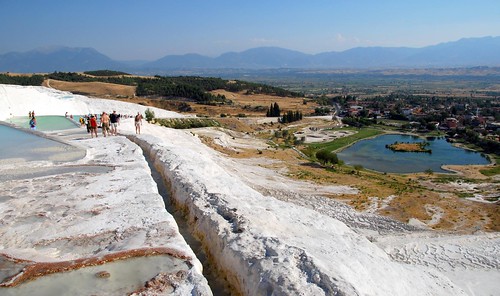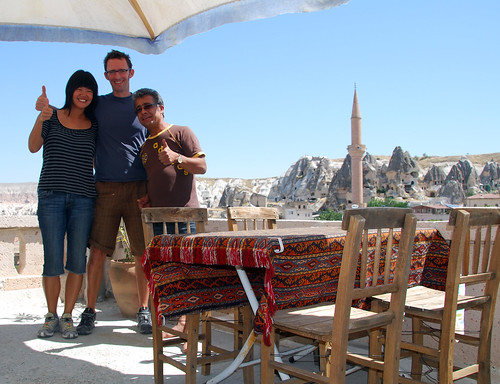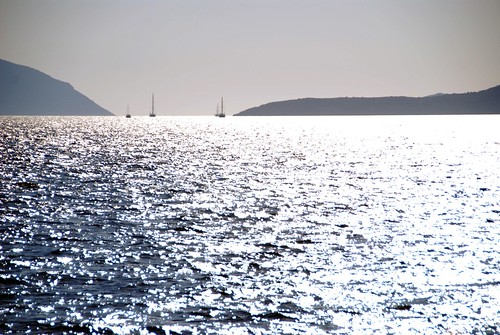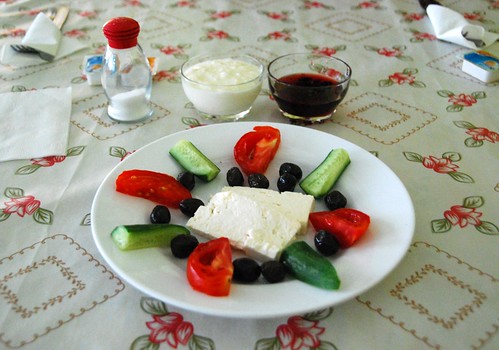I’ve been trying to find words that can capture the incredible affection we’ve developed for Turkey, and I’m afraid that nothing I write can adequately describe how amazing this place is. Like our three other favorite countries (New Zealand, Taiwan, and Japan), Turkey feels magical somehow. Maybe it’s the jaw-dropping landscape, maybe it’s the kind and generous people, maybe it’s all that incredible art and architecture. Or maybe it’s all three of those things. All I know is: this planet is a better place because of Turkey. Need we find more words than that?

Jaw-dropping landscape. Check.

Kind and generous people. Check.

Incredible art and architecture. Check and double check.
Days spent here: 28 (August 11-September 8, 2009)
Highlights: Heads up, mouths agape in Istanbul, boat trips in the Turkish Mediterranean, exploring surreal landscapes in Pamukkale and Cappadocia, getting off the beaten path in Eastern Turkey.
Places we would like to visit next time: Mardin, and more of Eastern Turkey. Also, we’d love to explore the Black Sea coast in depth.
Average daily expenditures (for two people): US$120/day
Prices: There are rumors floating around that Turkey is not really the bargain basement European destination it once was, and while that’s probably true, once you get out of Istanbul, prices can drop dramatically. After a false start in Istanbul with THE WORST HOSTEL EVER, we moved to a much more pleasant place for €45 (US$60) per night. €45!!! (And that room was one of the cheapest we found.) As a comparison, we averaged about half that much for similar rooms in the rest of Turkey.
Food is also cheaper once you get out of Istanbul, but not as dramatically so. We averaged around $5-7 each for lunch and about $10-12 each for dinner. Breakfasts are usually included in the room price (see “Food” section below).
Museum and entry fees can pack quite a punch in Turkey (apparently all ticket prices doubled in 2008), particularly when you are charged to enter the complex as well as individual buildings within a site (ex. entering the Harem in Topkapi Palace), so choose your carefully!

Pattern overload in the Harem, Topkapi Palace.
Transport in Turkey is not dirt cheap, but it is an extremely good deal—you can bus halfway across the country (a 15 hour ride) in a comfortable, clean vehicle with stewards serving you tea and cakes for 55 TL (US$40).
Guidebooks we used: Lonely Planet Turkey and Tom Brosnahan’s Turkey Travel Planner. After finding the LP indispensable throughout Southeast Asia, we were disappointed with our Turkey guide. It’s perfectly passable if you are sticking to the country’s most heavily touristed areas: Istanbul and the Aegean and Mediterranean coasts. But once you venture off that well-beaten path, information in the LP is either incorrect, incomplete, or (in some cases) incompetent.
Luckily, Turkey Travel Planner was able to fill in the gaps where the LP failed. Tom Brosnahan has amassed excellent information on destinations that are not quite as heavily touristed. We also found his posts on the best Turkish bus companies and travel during Ramazan very helpful.
Weather: We were in Turkey late summer/early fall, and the west and central parts of the country were HOT. There were rumors that the Mediterranean coast hit 40°C (104°F) after we left. Yowza!!! I can’t imagine how stifling it must get in the dead of summer.

The Mediterranean coast’s relentless sun.
The eastern side of Turkey was quite temperate, however, and at times downright cold (And rainy. And foggy. Oh yeah, and hail-y).
Overall, it was an excellent time to visit, since the temperatures were relatively moderate during this time of the year.
Food: Traveling through west and central Turkey, we found the food to be tasty, but quite repetitive. Three weeks of doner kebap with a side of lettuce, tomato, and cucumber two times a day will do that to you. Turkish breakfast is more of the same, minus the kebap. You can imagine how hard it was to go from an English breakfast every day to this!:

A typical Turkish breakfast: cucumber, tomato, feta cheese, olives (if you’re lucky), and bread.
As soon as we hit the east, however, Turkish food improved dramatically, both in taste and in variety. We ate Turkish fondue in the Kaçkar Mountains (at a lovely little family-run place named Yilmaz Cafeterya—if you’re ever in Ayder, you must go!), incredible lamb, yogurt, and eggplant dishes in Kars, and spiced ground beef with pine nuts stuffed inside a pastry shell in Van. So there you have it: east beats west. At least in Turkish cuisine.
Accommodation: We stayed in double rooms ensuite in budget guesthouses and pensions throughout Turkey and averaged about US$30 per night. Rooms and hotels in the east tend to be a little grungier than in west and central Turkey, but they are still adequately clean.
As I mentioned in a previous post, for the first time on the trip, we started going with the hotel touts whenever we arrived in a town (only in western Turkey—there were no touts in the central and eastern part of the country). Part of the reason is that touting in Turkey appears to be much more relaxed and low pressure (especially when compared to SE Asia)! We were never disappointed.
Transit: Turkish buses are amazing! Not only are they comfortable and clean, but little dudes in bow ties and cummerbunds serve you Turkish tea and cakes throughout the ride. Classy!

Turkish buses are nicer than this. We promise.
Internet: Every guesthouse we stayed in had wi-fi internet access either in the hotel or close enough to pilfer. The one exception was Ayder, though we were able to find a connection in the middle of town.
Culture: We’ve heard other people who’ve visited Turkey complain about how oppressed Muslim women are. We’ve heard solo women travelers complain about being sexually harassed. And we’ve heard tourists complain about being hassled at the markets.
I am sure all of those things are true. But if it wasn’t already clear by now, let me spell it out for you: our experiences with the Turks left us confident that they are the nicest, most generous, most hospitable people on the planet. Turkish people are AWESOME. Capital A. Capital W. Capital E. Capital SOME. AWESOME.
In short: It bears repeating: the world is a better place because of Turkey. ‘Nuff said.
Hope & Jeremy, you’re giving *excellent* advice and guidance on travel in Turkey, and your photos are nothing short of spectacular. What a talented pair!
Sorry to hear the LP Turkey guide is not up to snuff. I’m sure the authors work hard on it, but guidebook writing pays very little these days, so they may not be able to afford to go off the beaten path for research.
Keep up the good work, and happy travels!
Tom Brosnahan
TurkeyTravelPlanner.com
Those pictures are awesome! Where was the first one taken?
Tom, thank you so much for your nice comment! Katrina, the first photo was taken in Pamukkale. Check out our post about this magical place here: http://12foot3.com/?p=993